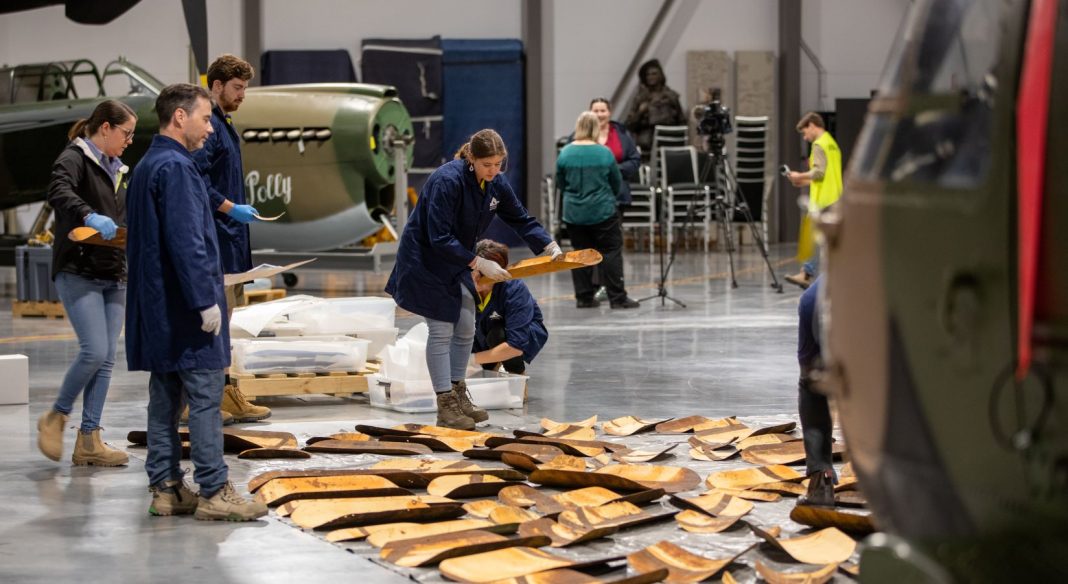A striking, contemporary sculpture comprised of 100 coolamons by Waradgerie woman, Lorraine Connelly-Northey, has been acquired by the Australian War Memorial to mark 100 years of Legacy – one for every year.
Commissioned with the support of Legacy Australia, the sculpture features 100 coolamons, also known as bush bowls, fashioned from salvaged metal.
Coolamons are multi-purpose vessels used by Indigenous communities across Australia for the preparation of food and sharing of resources.
Connolly-Northey said: “Coolamons are traditional Aboriginals implements used to winnow native grass seeds into flour for seedcakes to feed the protectors of our Country and abroad including Aboriginal soldiers who fought for freedom, one for every year of Legacy’s history.”
The work highlights the strength and resilience of Indigenous women as soldiers, mothers, wives, daughters, aunties and cousins, who support families and nurture kinship through a symbolic use of coolamon forms.
The Australian War Memorial Director, Matt Anderson, said: “This is an important work to bring into the National Collection.
“This work links Indigenous communities, Legacy and the Australian War Memorial. The work is a powerful reminder of the Legacy promise to care for families of veterans.”
Connolly-Northey uses salvaged materials, often associated with European settlement and industrialisation of the land, and makes them into sculptural works often using weaving techniques associated with Indigenous culture and the forms of cultural objects, such as coolamons.
Head of Art at the Memorial, Laura Webster, said: “Lorraine Connelly-Northey is one of Australia’s most important contemporary artists and we are delighted to have her newest work in our National Collection.
“This work increases the representation of the experiences of Aboriginal and Torres Strait Islander women and children in the Memorial’s collection.
“When displayed in the galleries, the scale and beauty of Lorraine’s work will engage visitors encouraging a broader understanding and acknowledgment of the role of women in caring and supporting families affected by war.”
The 100 coolamons represent a range of hues and textures, which reflect the different soils of Waradgerie Country, speaking to the significance of Country to Indigenous families.
Legacy Chairman, Eric Easterbrook OAM, said: “This sculpture is a way to recognise the Centenary of Legacy in Australia and ensure that it encapsulated everything that Legacy stands for and its connection with the Australian War Memorial. This is no better demonstrated than with this striking Indigenous artwork.”
Legacy started in the aftermath of the First World War through a promise to help veterans’ families carry on with their lives after the loss or injury of loved ones.
Today, 100 years on, Legacy supports 40,000 partners and children through essential medical, financial, developmental and social support for their families.
This artwork has been funded by benefactors to ensure that Legacy could make this presentation a reality. The benefactors of this artwork, John and Anna Belfer Trust, Wesley Browne OAM, Sari Browne OAM and family, felt this acknowledgement was necessary based on the deep connection with Legacy and returned service personnel.
Artist bio
Lorraine Connelly-Northey (b.1962, Swan Hill, Victoria)
Waradgerie (Wiradjuri)/Irish Settler heritage
Lorraine Connolly-Northey is a leading Australian sculptor who has exhibited nationally and undertaken many public commissions. Most recently, she was commissioned by the Art Gallery of NSW to create a work for the 20-metre-long window of the Yiribana Gallery at the entrance of Sydney Modern. In 2021, her work was celebrated in the major exhibition, Found and Gathered (2021), at the National Gallery of Victoria alongside the work of late Australian sculptor Rosalie Gascoigne (1917–1999).
Inspired by the Mallee and Riverina bush environments of north-western Victoria where she grew up, Connolly-Northey’s objects and installations relate to the history and culture of the Waradgerie and her personal connections to the land.
Connelly-Northey salvages materials from her mother’s Country, often associated with European settlement and industrialisation of the land, and repurposes them into sculptural works using weaving techniques associated with Indigenous culture and traditional objects, such as coolamons. Her work explores the dynamic nature of her country and heritage as traditional, progressive, resilient and innovative. Cultural knowledge takes precedence and is central to Connelly-Northey’ s life and work. The responsibility of holding and sharing this knowledge is undertaken with vitality and resolute commitment by the artist.
Get local, national and world news, plus sport, entertainment, lifestyle, competitions and more delivered straight to your inbox with the Canberra Daily newsletter. Sign up here.



